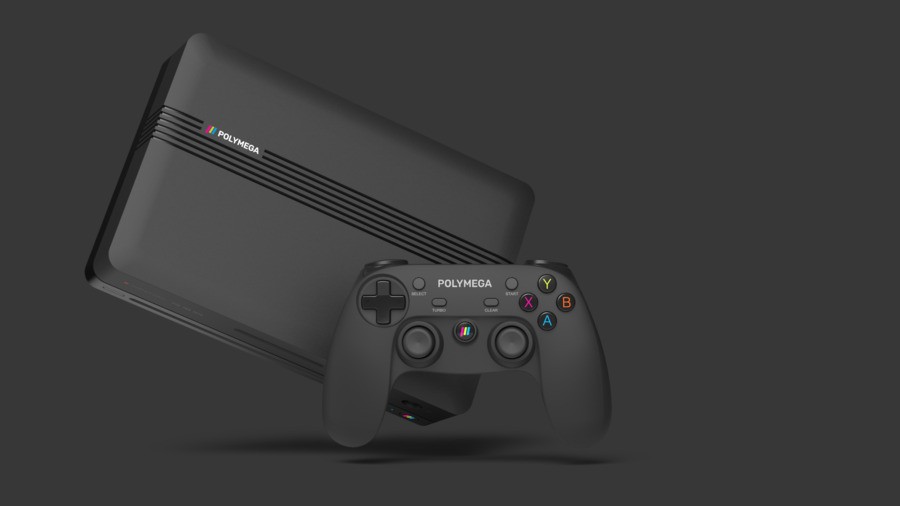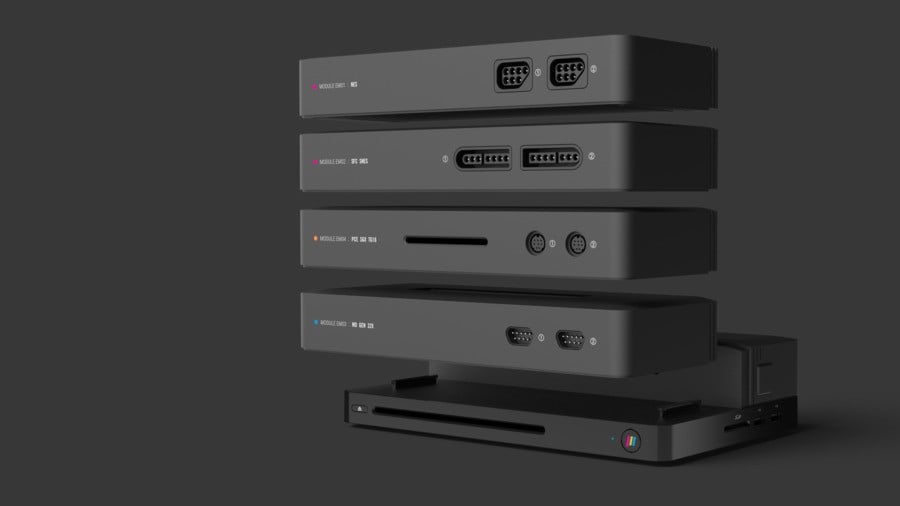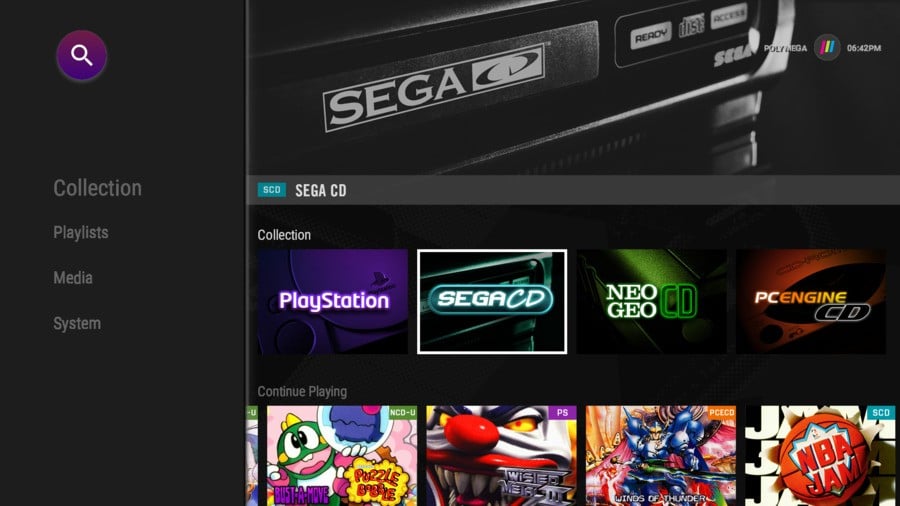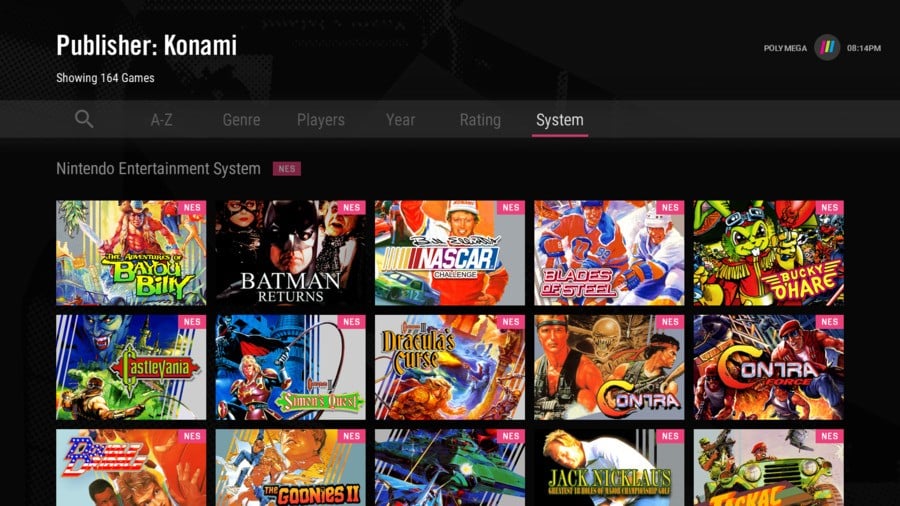
If you’ve been keeping your eyes on these pages, you know that we’re keenly interested in Polymega, the new retro console by Playmaji, Inc. We tracked down Bryan, the company’s founder on the E3 show floor last week to talk about, and more importantly, actually play the thing.
The Polymega is a sight to behold in the flesh; it looks every bit as beautiful as the professionally-made product shots would lead one to believe. Whether it’s sporting the dust cover, which is pictured attached to the console at the top of this page, or one of the element modules — plugins which allow players to use their original cartridges from either the Sega Mega Drive, TurboGrafx 16 or Neo Geo — this thing is an absolute joy to behold. Its striking lines contrast with the muted, matte black surface and there's just a small pop of colour in the logo to evoke an aesthetic that is simultaneously retro and modern. It’s just lovely.

Also on hand were the newly-revealed classic controllers, each of which will be bundled with a corresponding element module and are designed to mimic the look and feel of the originals. Each controller functioned as well as we remember our original NES, SNES, Sega Genesis/Mega Drive and TurboGrafx controllers feeling, but they felt a bit on the light side. We were told by the Polymega team that the controllers were not yet final and they were toying with the idea of making them a bit weightier, an addition we feel would be welcome. The build quality of the pads was solid and the buttons responded in a way that tickled the nostalgia centre of our brains. Each of the pads connected using the same proprietary plugs ‘80s and ‘90s kids are used to, and we were assured by the team that our original peripherals would work fine, if we opted to use those instead. We had the opportunity to test original Neo Geo and TurboGrafx controllers and can confirm they worked without issue.
The demo unit we tested at E3 supported all of the systems Polymega has announced to date, on original media, SD cards and internal memory. As soon as we grabbed the modern wireless controller — which Bernal told us was actually licensed from another company and was then branded with Polymega’s logo — we were off. The modern controller feels comfortable in the hand, similar to Sony’s DualShock. The D-pad takes centre stage, placed where you would expect to find it on a PlayStation controller, a choice that makes sense given the system’s focus on retro titles. The face buttons feel clicky and responsive and there wasn’t so much as a whiff of wireless latency when playing even the most demanding, twitchy 8-bit titles. Before we hopped into the games, however, we were keen to explore the system itself.
The user interface is every bit as responsive as it appears in the Polymega marketing material. It’s clear to us that the team at Playmaji, Inc. have put a lot of thought into how to make the experience for players with collections large and small as seamless as possible. At the top of the device’s home screen, you’ll see icons representing each machine the console is capable of emulating. Selecting one of those icons will display all the games you’ve copied to your Polymega that were originally released for the corresponding console. The Polymega remembers your recently played games as well, and it also allows you to create a list of favourites, along with custom game lists.
Once you find the game you’re looking for, pushing the start button on your controller will take you into it with no delay. We were shocked by how quickly games boot on the Polymega, even optical media-based games such as those on PlayStation. While the software running under the hood of the console isn’t yet final, the games we demoed ran as well as they did on their systems of origin. The team giving our demo was quick to note that it wasn’t quite yet perfect, however; games such as Star Fox, which shipped with a custom SuperFX chip inside the cart won't play as the team hasn't been able to accurately emulate the chip as yet.

Speaking of copying games, the process is dead simple, if a little on the slow side. When original media is inserted into the optical drive or one of the Polymega’s element modules, a small icon representing the media type will appear in the upper-right of the screen. Selecting it brings up a menu allowing you to install. Once you’ve done that, you can still play the game off of its original media as it’s copying, or play a different game you already have stored on the console, if you like. The systems detailing how much space is left on the Polymega (as well as notifications regarding game installation) weren’t functional in the version of the software we tried, but we were assured they would be by launch.
Our first run of a PlayStation game didn’t work quite as well as we had hoped, however. When booting up Tekken 3, we noted it was running very slowly, causing a brief moment of concern for those running the demo. We were informed the demo unit had been having some overheating issues due to the fact that the unit was not yet complete and didn’t have its final thermal solution in place. A quick reboot of the system saw PlayStation games once again running at full speed. For the rest of our demo, games ran smoothly. We’re hoping the team at Playmaji can sort out the thermal issues with enough time to manufacture and ship without delaying Polymega’s release.

All told, we spent about two hours with the console. Not quite enough for a full review or even solid impressions, but we came away impressed with what we saw. The Polymega seems to be the real deal, and if it is, it’s the retro console we’ve all been waiting for. We can’t help but feel the console is just a few tweaks away from being something truly special. If the speed and accuracy of the system can be maintained and the promised features we haven’t seen yet, like Twitch streaming, can be delivered in a way that both works and is easy to use, we don’t see any reason why fans won’t be champing at the bit to snap one up when pre-orders go up this Fall.
This article was originally published by nintendolife.com on Fri 22nd June, 2018.






Comments 63
superbe!
Already much better than the Atari VCS.
This bodes well.
Fair play to them, I have to admit I was very sceptical with this project but looks like they're set to prove me and plenty of others wrong. Hope it works out.
Is Polymega ready to sell ?
I can't wait to play PlayStation One games ALL Region.
This is amazing and I will get getting one of these day one. I no longer have to fear about cartridges going bad.
Sure would be great to have if the underlying emulation solutions are properly sourced and licensed. Also it's kind of amazing something like this is possible from an upstart and all Atari could turn out was pieces of plastic.
Sounds great, but also very, very, VERY expensive.
Been keeping an eye on this, will be first day purchase for me
It just looks so beautiful.
This is gonna be so good.
@zafira Are you this Anonymous poster?
http://polymega.com/forums/topic/quality/
They were awfully rude and Polymega still responded.
I hope the music is the actual menu music
@AirElephant turns out that they plan to make this cost less than a switch, so it won't be too bad!
If it is not FPGA it is not worth it IMO
I'm impressed.
@AirElephant Yeah, I'm hoping each module isn't breaking the bank so I can buy one or two at the start then add more over time.
@Riderkicker The modules are supposed to be $59.99 each.
@Fearful-Octopus That price works for me. Heck, I was expecting $80+ so I'd be pleased if they can keep it even lower.
Sounds like it will be very expensive i think i will stick to an rpi3 and retropie
@Riderkicker What set will you buy for your starter, i might go with sega and pick up the nes, and snes module. I don't have any nostalgia for turbo graphx 16 because i never owned one.
My wallet is ready!
Anybody else notice the Smash Bros. Ultimate theme (remixed) playing in the background between 1:21 and 1:49?
@AlexOlney I'm guessing you knew about this.
@Fearful-Octopus Probably SNES for starters. Think it's still the single biggest library I own & many of them I never re-bought on the Virtual Console. Then again I could get around to finishing Tales of Destiny if I get the PS1 module.
If they can do Saturn I am so in!
@subpopz Well, the draw is that it is FPGA-based combined with emulators, potentially making it the best of the bunch, save for clone consoles that actually run the cartridges directly. And besides that, it's also quite customer-friendly in that it has one base unit, and for each console, a small click-on module, that has all the necessary connectors for cartridges and controllers.
All of which are smaller, and take up less space than having all the original consoles still hooked up, not to mention that this would also mean far more cables, and converters, if your TV doesn't have the old connectors anymore.
The Polymega runs everything from one unit, so only one cable is needed, and you just switch out cartridge modules if you want to play games from another console.
And another advantage is that each module comes with its own, dedicated internal hardware, that combines with their custom software to improve results of the emulation.
@Jokerwolf The Polymega actually IS based on FPGA, combining both hardware and software to control the emulation, so perhaps you should have informed yourself a little better before making that comment...
Useful site links:
http://polymega.com/
http://polymega.com/frequently-asked-questions/
And here's a quite insightful NLife interview with one of the creators:
http://www.nintendolife.com/news/2017/02/exclusive_getting_under_the_hood_of_polymega_the_clone_console_to_rule_them_all
@Fearful-Octopus You don't really need to have nostalgia for any one console, to still be able to appreciate, or learn to appreciate, its games.
But having said that, the Turbografx 16/PC Engine had lots of great games, some of which were even the best versions of the games available at the time, such as the CD version of the Japanese version of Castlevania: Rondo of Blood, which was later remade on the SNES, in a slightly lesser version called Castlevania Dracula X.
You can probably quite easily imagine that, because of the PC Engine version being released on CD-ROM, the music and sound effects were far superior, and I do believe that the game itself was also more elaborate because it didn't have to stick to the limitations of cartridges.
And there are quite a few other games that were worth playing, some even completely exclusive to the system. It had a lot of great side scrolling shooters, platformers and fighters, so even today, it's still well worth looking into, if you like retro gaming.
The real question for me is :
Can I plug a Polymega on a real CRT with SCART connector to play my games in 240P ?
This is the only thing that I'm interessed in...
If the answer is YES YOU CAN, INSTA BUY !
get me 3DO support and I will buy five!
The concept is exceptional. Too much for me anyway. But love the idea that this exists.
@ThanosReXXX Oh I know, but they should look to the Analogue NT/Super NT and the new PC Engine expansion where they are system perfect experiences with 100% comparability, mind you if they can get it perfect with a combination of both then all the power to them.
It's definitely very slick-looking console, from the main machine to the various controllers and even the menu designs.
I'll buy any emulator console that doesn't have AtGames quality emulation.
Keeping a close eye on this. I don't own many old games, maybe x20 or so MegaDrive, x5 or so Mega CD, x10 PS1 and around x9 NES games. At present I only have the NES, which remarkably still works.
I've tried retropie, it's good, but still doesn't quite feel right.
I'm torn as to whether I should be interested in this, like I said, I don't have a massive collection. Confused, but definitely intrigued.
@ThanosReXXX Very valid point i don't own any turbo graphx 16 games, but aren't they very expensive? I love retro lol. I also have a ton of ps1 games! I really hope this system delivers!
@Yorumi Maybe i will reconsider, i didn't mean i don't like turbo graphx 16 just never played one.
Will it be able to play repros and homebrew games as well? I hope it support Pier Solar for Genesis and Dreamcast, Secret of Mana 2 for Super NES, Wolfenstein 3D for Sega Genesis, Final Fantasy VII demake for NES, and Mega Man: The Wily Wars for Sega Genesis.
@Riderkicker I have alot of ps1 games just picked up legacy of kain soul reaver. I would love to play resident evil 1-3, Dino crisis 1-2 and metal gear solid in hd without having to hook up my ps3. 😊
@Cobalt I’ve just checked their site and it’s HDMI output only, which is a shame but understandable.
@subpopz Totally agree. I don't see the point of this device. There are much cheaper and easier ways of emulating retro titles. I suppose emulating the CD-based consoles is the Polymega's killer app, but frankly I have zero nostalgia for those consoles.
@GravyThief
Thanks dude
I have a converter HDMI to SCART so I know that I could plug the system BUT I'd like to know if the Polymega is able to output a native resolution or not...
For the moment, I'll play with original hardwares still.
Thanks again for the reply.
Looks nice, but I have seen stuff like this before. Lets see how it turns out.
@Yorumi Cool man, yeah I hope they get the Super FX games issue fix soon. Nice that homebrew and repros won't be hampers.
@Jokerwolf Agreed on that. I've been following them ever since the system was still called Retroblox, and from what they've achieved so far, this certainly looks extremely promising.
On a side note: and now that it is proven to be real, the idiots that called this vaporware, are nowhere to be seen...
@Fearful-Octopus Well, that depends. There are actually quite a few games that are still reasonably affordable on the cartridge based version. It's mostly the CD based games that are either rare or expensive.
And of course we're talking grey area here again, but seeing as this was an old, non-copy protected system, I'd wager it would be quite easy to make your own PC Engine CD's, and these would, or should install just as well as genuine discs.
Interesting idea, although swapping modules sounds like a bit of a chore. What do the modules do other than read original media and allow the use of original controllers? Is there any actual processing in them?
I still have original hardware set-up and working (MD, MCD, and SS) so I don't technically need one of these, but I'll keep an eye on it.
Any word on what sort of output this will have? I assume 1080p, but what about CRT effects? A good CRT filter (such as CRT-Royale, CRT Easy Mode, and Hyllian) can make a modern display look so much better with old games. The CRT filter in the SNES Mini was utter garbage.
@JAPBOO for a second I took you serious.
@ThanosReXXX
I'm still skeptical they are using the fpga for playing games. Kevtris speculated that they were using a small fpga to dump the cartridge and send the feedback from the cartridges. He was skeptical they would need emulation if they were using a big enough fpga board for the systems. I guess we'll know what their plan is when they release it. I'm just not sure the benefit over using pc if it's primarily emulation. Really surprised thet can't get superfx working. I was playing super fx on my original windows xp computer via emulation. I'm also dissapointed that this article implies the controllers are lag free wireless. Such a thing doesn't exist.
Aside from supporting carts for certain systems, it doesn't appear to be doing anything better than the nVidia Shield TV.
This was just confusing to me, not a very good write-up. All I read was "we can't emulate Star Fox properly yet" and Tekken 3 plays like crap....but the system is good because reasons.
Also, that XBAY button set-up can die in a fire
Be prepared for lots of disappointment.....
Here's the red flag.... "games such as Star Fox, which shipped with a custom SuperFX chip inside the cart won't play as the team hasn't been able to accurately emulate the chip as yet."
What you can assume from this is, it's not interacting with carts at all. It's a rom dumper and emulation. It won't work with flash carts either.
Why would you need to emulate the superfx if it's already on the cart? Because just like the retron5 it can't interact with the cart. It's dumping the cart rom then emulating.
They might be mentioning FPGA because people see that and think Super NT / AVS hardware emulation. But needing to "emulate the superfx"... yeah save yourself a small fortune and get a retron5 or a real FPGA hardware emulated system.
@cleveland124 Well, it's mentioned in the interview I linked to, that they started with thinking about that (FPGA), and then going from there, to create a device that was more accurate in its emulation, and ended up with a formula that's 50% hardware and 50% software. They call it "hybrid emulation".
What it exactly entails, is anyone's guess, but the way that he describes it, does sound like the device actually IS interacting with the cartridge on a deeper level than just software emulaton or rom dumping.
@SethNintendo It's more like installing a game from disc. You could say it is much like modern consoles: the physical disc/cartridge is only necessary to install the game. Except, contrary to modern consoles, the disc doesn't need to be in the drive to play, once it's installed.
http://polymega.com/
http://polymega.com/frequently-asked-questions/
@moroboshi The use of swapping out modules is because the base unit provides the power and the emulation, and the modules contain console-specific hardware and connectors, so you can play with original controllers.
I posted all the necessary info in comment #31 (and in the comment above this one), if you're interested to find out more.
While it's not my usual preference, I admit that giving the the D-Pad the more prominent placement makes sense for a controller that will be playing mostly 2D games, but who's the idiot who designed the face buttons so that A and B are no longer next to each other?
If someone makes a hack to play off SD card without the cartridge inserted, I’m in. The whole point of a console like this for me is to dump my games on memory and not have to swap out game cartridges. Otherwise, it’s a bit too expensive and I’m cheap enough to just drag my old consoles out when I want to play them.
It does look fantastic though.
@SethNintendo That's not burning, that's ripping. Burning is always the other way around: you can burn video, audio or data to a CD, DVD or Bluray, but you cannot burn anything to a hard drive.
How Polymega handles games is, like I already said, the exact same way as how the current gen consoles do it: installing the data to internal storage. Actually much like how you would install a game on your PC.
@RunninBlue You only need to use the cartridge once. After that, it stays in the internal storage. You can play from the cartridge if you want, but it's not necessary.
@ThanosReXXX Does the cartridge need to be inserted to start the game everytime? Like, as an authentication?
@RunninBlue From what I've understood, it doesn't. You DO need the original cartridges, so indirect rom dumps or downloads don't work, but for any disc or cartridge game, once installed, you can leave it out, so it shouldn't be needed anymore.
But you can always ask them yourself by contacting them. I've posted links to their site and their FAQ page in comment #61.
@Joe-b I was, maybe not getting that man but yes on buying at least 2... my 3DOs keep on breaking, and I still enjoy replying some of the games now and then...wish this or seede were planning on supporting 3DO
why always those old 2d games.
is their nobody anno 2018 that can build a worthy 3d system that fits under your tv for dreamcast, gamecube, psx. even with an upscaling system.
the only thing you need is a blu-ray player, software and drivers and a hdd for savefiles. is that so hard to invent? no im not talking about a illegal device for roms and isos. just any best emulated disc based console system.
@ThanosReXXX I think it is an amazing idea overall, and it will be a proper competitor to the RetroFreak, I mean probably better since it is partially FPGA .
@Jokerwolf And it looks good too. Some of these retro-clones look so cheap or garish, regardless of how good they are or aren't. And most of them have lousy controllers. These guys here actually made a real effort to offer you a decent alternative for the original controllers of all the various types of consoles they intend to add.
@PALversusNTSC I think you must have missed the bit where it says that it also supports CD-based consoles...
For now, the only "above 16-bit" console that is supported, will be the PSX, but they are seriously considering adding Saturn, Dreamcast and perhaps even more.
I'd be down for this if it allows for you to run patches on the games the way Retroduo does. I would love to play all 3 Shining Force 3 games in English via physical media. As of right now, my only real option is to simply emulate them (Despite owning the first game), since the mod chips and such have become a bit rare. Another important tidbit is if this system supports 1080p. I ASSUME it does since it's a modern system. If that's the case, they really need to advertise this fact to their advantage as many of these older games don't look or play right on modern HDTVs. Being able to emulate them all without expensive cables or boxes would be a huge boon to both collectors and casual players alike.
I don't normally dig clone consoles, but this and the AVS are starting to really appeal to me. I need to consider doing the whole Retron 5 thing too at some point. While I love having the original hardware, original hardware is sometimes a pain.
Show Comments
Leave A Comment
Hold on there, you need to login to post a comment...